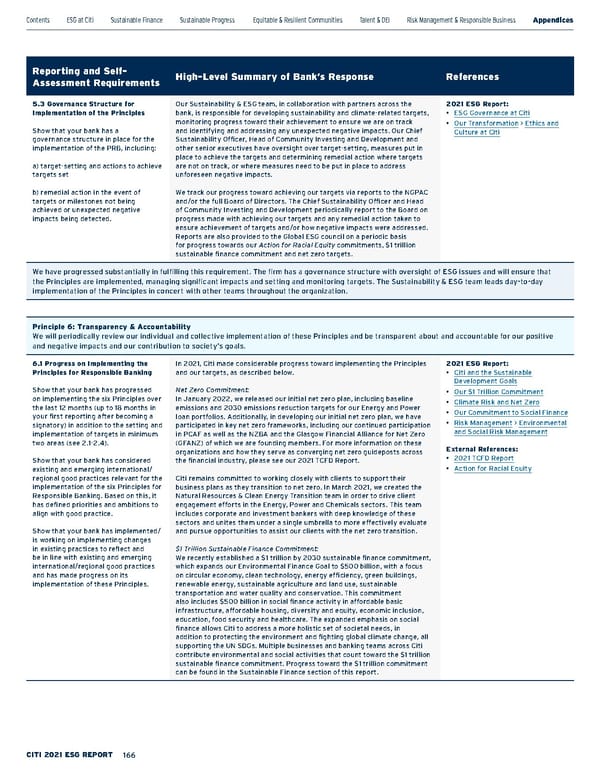Reporting and Self- Assessment Requirements High-Level Summary of Bank’s Response References 5.3 Governance Structure for Implementation of the Principles Show that your bank has a governance structure in place for the implementation of the PRB, including: a) target-setting and actions to achieve targets set b) remedial action in the event of targets or milestones not being achieved or unexpected negative impacts being detected. Our Sustainability & ESG team, in collaboration with partners across the bank, is responsible for developing sustainability and climate-related targets, monitoring progress toward their achievement to ensure we are on track and identifying and addressing any unexpected negative impacts. Our Chief Sustainability Officer, Head of Community Investing and Development and other senior executives have oversight over target-setting, measures put in place to achieve the targets and determining remedial action where targets are not on track, or where measures need to be put in place to address unforeseen negative impacts. We track our progress toward achieving our targets via reports to the NGPAC and/or the full Board of Directors. The Chief Sustainability Officer and Head of Community Investing and Development periodically report to the Board on progress made with achieving our targets and any remedial action taken to ensure achievement of targets and/or how negative impacts were addressed. Reports are also provided to the Global ESG council on a periodic basis for progress towards our Action for Racial Equity commitments, $1 trillion sustainable finance commitment and net zero targets. 2021 ESG Report: • ESG Governance at Citi • Our Transformation > Ethics and Culture at Citi We have progressed substantially in fulfilling this requirement. The firm has a governance structure with oversight of ESG issues and will ensure that the Principles are implemented, managing significant impacts and setting and monitoring targets. The Sustainability & ESG team leads day-to-day implementation of the Principles in concert with other teams throughout the organization. Principle 6: Transparency & Accountability We will periodically review our individual and collective implementation of these Principles and be transparent about and accountable for our positive and negative impacts and our contribution to society’s goals. 6.1 Progress on Implementing the Principles for Responsible Banking Show that your bank has progressed on implementing the six Principles over the last 12 months (up to 18 months in your first reporting after becoming a signatory) in addition to the setting and implementation of targets in minimum two areas (see 2.1-2.4). Show that your bank has considered existing and emerging international/ regional good practices relevant for the implementation of the six Principles for Responsible Banking. Based on this, it has defined priorities and ambitions to align with good practice. Show that your bank has implemented/ is working on implementing changes in existing practices to reflect and be in line with existing and emerging international/regional good practices and has made progress on its implementation of these Principles. In 2021, Citi made considerable progress toward implementing the Principles and our targets, as described below. Net Zero Commitment: In January 2022, we released our initial net zero plan, including baseline emissions and 2030 emissions reduction targets for our Energy and Power loan portfolios. Additionally, in developing our initial net zero plan, we have participated in key net zero frameworks, including our continued participation in PCAF as well as the NZBA and the Glasgow Financial Alliance for Net Zero (GFANZ) of which we are founding members. For more information on these organizations and how they serve as converging net zero guideposts across the financial industry, please see our 2021 TCFD Report. Citi remains committed to working closely with clients to support their business plans as they transition to net zero. In March 2021, we created the Natural Resources & Clean Energy Transition team in order to drive client engagement efforts in the Energy, Power and Chemicals sectors. This team includes corporate and investment bankers with deep knowledge of these sectors and unites them under a single umbrella to more effectively evaluate and pursue opportunities to assist our clients with the net zero transition. $1 Trillion Sustainable Finance Commitment: We recently established a $1 trillion by 2030 sustainable finance commitment, which expands our Environmental Finance Goal to $500 billion, with a focus on circular economy, clean technology, energy efficiency, green buildings, renewable energy, sustainable agriculture and land use, sustainable transportation and water quality and conservation. This commitment also includes $500 billion in social finance activity in affordable basic infrastructure, affordable housing, diversity and equity, economic inclusion, education, food security and healthcare. The expanded emphasis on social finance allows Citi to address a more holistic set of societal needs, in addition to protecting the environment and fighting global climate change, all supporting the UN SDGs. Multiple businesses and banking teams across Citi contribute environmental and social activities that count toward the $1 trillion sustainable finance commitment. Progress toward the $1 trillion commitment can be found in the Sustainable Finance section of this report. 2021 ESG Report: • Citi and the Sustainable Development Goals • Our $1 Trillion Commitment • Climate Risk and Net Zero • Our Commitment to Social Finance • Risk Management > Environmental and Social Risk Management External References: • 2021 TCFD Report • Action for Racial Equity Contents ESGatCiti SustainableFinance SustainableProgress Equitable&ResilientCommunities Talent&DEI RiskManagement&ResponsibleBusiness Appendices ESGS ataC ius niblnG 166
 Citi ESG Report Page 165 Page 167
Citi ESG Report Page 165 Page 167